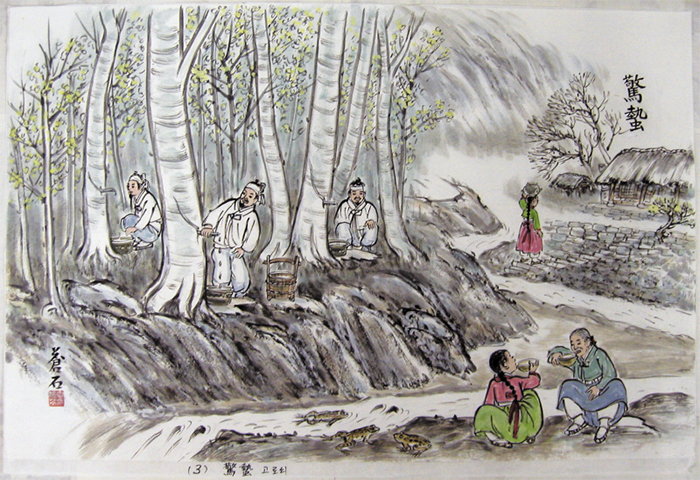Gyeongchip (경칩, 驚蟄) is the Day of Awakening From Hibernation and falls on Saturday, March 5, this year. It marks the beginning of the third of 24 solar terms of the year. As all living things in the northern hemisphere begin to emerge from their winter slumber, the continental anticyclone wind patterns (clockwise in the northern hemisphere) begin to weaken. The Korean Peninsula is hit by low pressure troughs, causing an alternation between both cold and warm weather, but temperatures still creep ever upward.
The Joseon royal family held traditional farming rites on its private farmland on the First Pig Day after Gyeongchip, setting an example for the commoners. The king also often issued bans on burning the fields to protect early grasses and insect eggs.
One custom associated with Gyeongchip was hunting for frog or salamander eggs in the rice paddies, ponds and ditches. It was believed that eating those eggs would keep one healthy throughout the year.

Gyeongchip was also considered a day on which all work associated with dirt could be done successfully. Thus, people frequently repaired the walls in their mud-plastered houses or built mud fences, even if there was no real need to do so, as this repair work was believed to eliminate bedbugs from the house. In homes which were infested with bedbugs, a bowl of water mixed with wood ashes was placed in each of the four corners of the room.
Also on Gyeongchip, people tried to predict the success of the farming seasons in the year ahead by looking at how well the barley had germinated by this day.
They drunk sap from the trunks of maple trees, as this was believed to have healing benefits for gastric disorders and intestinal diseases. Maple sap had to be collected on a clear day because, according to a popular belief, cloudy or windy weather would spoil the positive energy on this day. After Gyeongchip, the amount of sap available in the maple trees falls sharply and the sap was thought to lose its healing qualities.
By Gregory C. Eaves
Korea.net Staff Writer
Photos: Encyclopedia of Korean Folk Culture
gceaves@korea.kr
The Joseon royal family held traditional farming rites on its private farmland on the First Pig Day after Gyeongchip, setting an example for the commoners. The king also often issued bans on burning the fields to protect early grasses and insect eggs.
One custom associated with Gyeongchip was hunting for frog or salamander eggs in the rice paddies, ponds and ditches. It was believed that eating those eggs would keep one healthy throughout the year.

Gyeongchip marks the beginning of the third of 24 solar terms of the year.
Gyeongchip was also considered a day on which all work associated with dirt could be done successfully. Thus, people frequently repaired the walls in their mud-plastered houses or built mud fences, even if there was no real need to do so, as this repair work was believed to eliminate bedbugs from the house. In homes which were infested with bedbugs, a bowl of water mixed with wood ashes was placed in each of the four corners of the room.
Also on Gyeongchip, people tried to predict the success of the farming seasons in the year ahead by looking at how well the barley had germinated by this day.
They drunk sap from the trunks of maple trees, as this was believed to have healing benefits for gastric disorders and intestinal diseases. Maple sap had to be collected on a clear day because, according to a popular belief, cloudy or windy weather would spoil the positive energy on this day. After Gyeongchip, the amount of sap available in the maple trees falls sharply and the sap was thought to lose its healing qualities.
By Gregory C. Eaves
Korea.net Staff Writer
Photos: Encyclopedia of Korean Folk Culture
gceaves@korea.kr